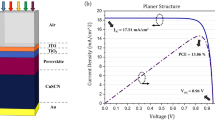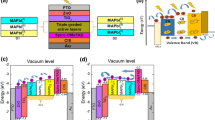Abstract
Perovskite solar cells (PSCs) have attracted significant attention in recent years due to the rapid increase in device efficiency (reaching over 25% in 2019), ease of fabrication, and the potential to produce low-cost photovoltaic modules. In this paper we have determined the ideal power conversion efficiency and quantum efficiency of PSCs with the p–i–n device structure, where p is the hole transport layer, i is the perovskite absorber layer, and n is the electron transport layer. The absorption of incident light occurs in a thin perovskite layer, the thickness of which is comparable to the wavelength of absorbed light. We take into account interference effects when the PSC structure is represented by a Fabry–Perot resonator. The optical flux within the absorbing layer is calculated as a function of the spatial coordinate (in the direction of the layer thickness), for a certain wavelength, at the normal incident light. The power quantum efficiency is calculated assuming that the incident light source is a blackbody at the temperature of the Sun, as well as for the AM1.5g standard solar spectrum. The results obtained by using the derived expressions that take into account the interference effects are compared with those obtained by neglecting these effects.




Similar content being viewed by others
References
Belghachi, A.: Theoretical calculation of the efficiency limit for solar cells. In: Kosyachenko, L.A., (ed.) Solar Cells: New Approaches and Reviews, Chapter: 2, pp. 47–76, INTECH, 2015. https://doi.org/10.5772/58914
Benmessaoud, I.R., Mahul-Mellier, A.-L., Horváth, E., Maco, B., Spina, M., Lashuel, H.A., Forró, L.: Health hazards of methylammonium lead iodide based perovskites: cytotoxicity studies. Toxicol. Res. 5, 407–419 (2016)
Chen, D., Xi, H., Zhang, C., Chang, J., Lin, Z., Zhu, W., Pang, S., Yang, H., et al.: Simulation study towards high performance transparent-conductive-oxide free perovskite solar cells using metal microcavity and optical coupling layer. IEEE Photonics J. 10(2), 1–9 (2018)
Chen, H.-L., Cattoni, A., De Lépinau, R., Walker, A.W., Höhn, O., Lackner, D., Siefer, G., et al.: A 19.9%-efficient ultrathin solar cell based on a 205-nm-thick GaAs absorber and a silver nanostructured back mirror. Nat. Energy 4, 761–767 (2019)
Cherrette, V.L., Hutcherson, C.J., Barnett, J.L., So, M.C.: Fabrication and characterization of perovskite solar cells: an integrated laboratory experience. J. Chem. Educ. 95, 631–635 (2018)
Djurić, Z., Radjenović, B.: Rise time of silicon p–i–n photodiodes. Solid State Electron. 26(12), 1143–1149 (1983)
Djurić, Z., Danković, T., Randjelović, D., Šušnjar, Z.: Interference effects influence on short circuit current of resonant-cavity enhanced photodetectors. In: Proceedings of 21st international conference on microelectronics MIEL 97, vol. 1, pp. 265–268, Niš, Yugoslavia, September 14–17 (1997)
Djurić, Z., Krstajić, P., Smiljanić, M., Randjelović, D.: The effect of diffusion on the impulse response of RCE detector. IEEE Photonics Technol. Lett. 13(6), 620–622 (2001)
Haegel, N.M., Atwater Jr., H., Barnes, T., Breyer, C., Burrell, A., Chiang, Y.-M., De Wolf, S., et al.: Terawatt-scale photovoltaics: transform the global energy system. Science 364(6443), 836–838 (2019)
Kalogirou, K.A.: Solar Energy Engineering: Processes and Systems. Academic Press, Amsterdam (2014)
Kojima, A., Teshima, K., Shirai, Y., Miyasaka, T.: Organometal halide perovskites as visible-light sensitizers for photovoltaic cells. J. Am. Chem. Soc. 131, 6050–6051 (2009)
Manzoor, S., Häusele, J., Bush, K.A., Palmstrom, A.F., Carpenter, J., Yu, Z.J., Bent, S.F., et al.: Optical modeling of wide-bandgap perovskite and perovskite/silicon tandem solar cells using complex refractive indices for arbitrary-bandgap perovskite absorbers. Opt. Express 26(21), 27441–27460 (2018)
Miyasaka, T., Kulkarni, A., Kim, G.M., Öz, S., Jena, A.K.: Perovskite solar cells: can we go organic-free, lead-free, and dopant-free? Adv. Energy Mater. (2019). https://doi.org/10.1002/aenm.201902500
NREL Reference Solar Spectral Irradiance: Air Mass 1.5 (2011). www.nrel.gov
Pettersson, L.A.A., Roman, L.S., Inganas, O.: Modeling photocurrent action spectra of photovoltaic devices based on organic thin films. J. Appl. Phys. 86, 487–496 (1999)
Sandberg, O.J., Armin, A.: On the effect of surface recombintion in thin film solar cells, light emitting diodes and photodetectors. Synth. Methods 254, 114–121 (2019)
Sherkar, T.S., Momblona, C., Gil-Escrig, L., Bolink, H.J., Koster, L.J.A.: Improving perovskite solar cells: insights from a validated device model. Adv. Energy Mater. 7(1602432), 1–9 (2017)
Shockley, W., Queisser, H.J.: Detailed balance limit of efficiency of p–n junction solar cells. J. Appl. Phys. 32, 510–519 (1961)
Steenhoff, V., Theuring, M., Vehse, M., von Maydell, K., Agert, C.: Ultrathin resonant-cavity-enhanced solar cells with amorphous germanium absorbers. Adv. Opt. Mater. 3(2), 182–186 (2015)
Űnlű, M.S., Strite, S.: Resonant cavity enhanced photonic devices. J. Appl. Phys. 78, 607–639 (1995)
Zhang, F., Zhu, K.: Additive engineering for efficient and stable perovskite solar cells. Adv. Energy Mater. 1902579, 1–26 (2019)
Acknowledgements
This work is a part of the research funded by the Serbian Academy of Sciences and Arts within the Project F-150 and the Serbian Ministry of Education, Science and Technological Development within the Project TR32008.
Author information
Authors and Affiliations
Corresponding author
Additional information
Publisher's Note
Springer Nature remains neutral with regard to jurisdictional claims in published maps and institutional affiliations.
This article is part of the Topical Collection on Advanced Photonics Meets Machine Learning.
Guest Edited by Goran Gligoric, Jelena Radovanovic and Aleksandra Maluckov.
Rights and permissions
About this article
Cite this article
Djurić, Z., Jokić, I. Ideal efficiency of resonant cavity-enhanced perovskite solar cells. Opt Quant Electron 52, 230 (2020). https://doi.org/10.1007/s11082-020-02342-4
Received:
Accepted:
Published:
DOI: https://doi.org/10.1007/s11082-020-02342-4




